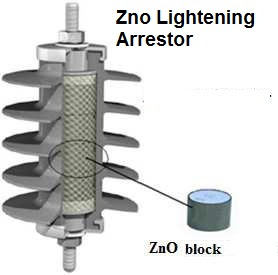Over voltages in power system may occur due to lightning or switching operation. These overvoltages could reach dangerous amplitudes for power system apparatus. To protect the system electrical equipment and to guarantee an economic and reliable operation, surge arresters are applied in almost all types of electrical power network. Gapless zinc oxide (ZnO) surge arresters are widely used. The surge arresters are usually connected between the phase and ground terminals. They limit the voltage level in equipments such as transformers below the withstand voltage level.
Figure below shows the values of overvoltage which can be reached without the use of arrester in per units.
The time axis is divided into the range of lightning overvoltage in microsecond, switching overvoltage in millisecond and temporary overvoltage in second. In the lightning overvoltage and switching overvoltage range, the magnitude of overvoltage can reach several per unit if the system is without arrester protection. Arrester could limit overvoltage below withstand voltage of equipment. This phenomenon clearly shows the importance of arresters for lightning overvoltage protection.
Construction of Zinc Oxide Surge / Lightening Arrester:
The construction of ZnO Lightening Arresters is very simple. They consist of an insulating housing which is made of porcelain and the inner column is made of the ZnO blocks as shown in Figure below.
ZnO block provide the Voltage- Current non-linear characteristics which serves the main purpose for the protection from overvoltage. Thus we can say that ZnO block has non-liner resistivity.
Voltage Current Characteristics of Zno Block:
Figure below shows the V-I characteristics of ZnO element which are divided into three regions, being low current region (A), operating region (B) and high current region (C).
The non linear resistance characteristics of ZnO block can be expressed as shown below,
I/Ir = (V/Vr)x
Where
Ir = Reference Current of Zno block
Vr = Reference Voltage of Zno block
x= Constant the value of x is 30 to 40 in case of Zinc oxide block.
Working Principle of Lightening / Surge Arrestor:
When system voltage is applied on the surge arrester at continuous operating voltage, about 80% of the rated voltage, the arrester experiences some leakage current. The amplitude of the leakage current depends on the condition of the surge arrester. The leakage current consists of the capacitive and the resistive current component. This leakage current generates heat. This generated heat should be dissipated properly otherwise the temperature of the LA may rise which further increases the leakage current. Because of this the proper thermal design of surge arrester housing plays an important role.
When a high voltage surge is impressed on the surge / lightening arrestor, the resistance of the ZnO becomes low and as can be seen from the voltage-current characteristics, the current through the Lightening / Surge Arrestor becomes high of the range of kA. The voltage, beyond which the current through the LA becomes such high, is known as reference voltage and the current at reference voltage is known as reference current. As LA is connected in between phase and ground, the high voltage surge is discharged to ground by low resistance offered by the Zinc Oxide blocks and in this way prevents the equipment from damage due to voltage surge.
Thank you!


